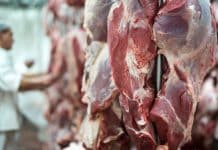In part 1 of this series, I explained why we often see cattle with long claws and I touched on the principles that must be kept in mind whenever the subject of feet comes up.
For the most part, long and overgrown claws in cattle reflect on the owner or the environment in which cattle are kept and not the animal itself. In part 2 of this series, I want to discuss instances where the genetics and conformation of the animal have a negative impact on claws.

Common claw problems
The conformation of the legs plays a major role in the appearance of the claws. If we keep the principle of growth-to-wear ratio in mind, it makes perfect sense. Cattle with good conformation will have claws that wear down evenly, symmetrically and at a good hoof angle. The same applies to cattle with bad conformation.
Sickle-hocked cattle will develop a short heel, a long toe, and a shallow hoof angle because the heel wears down more than the toe. This is often accompanied by a long and sloping pastern.

Post-legged cattle tend to have a claw with a short toe, a long heel, and a steep hoof angle because the toes wear down faster than the heels.

Cow-hocked cattle usually have a short inner claw and a long heel on the outer claw because of too much wear on the inner claw and not enough on the outer claw.

Bowlegs, which can be found in both the front and hind legs of cattle, is the opposite of cow-hocks. The whole leg is bowed, the feet are close together and the inside claws will be longer on the heel than the outside claws.
Corkscrew claws is a condition where one claw on a foot does not match the other claw of the same foot. Most people identify corkscrew claws as the long, sharp point on the tip of the toe on one of the two claws on the same foot. However, this is not an accurate identification method, because whenever there are hard surfaces, lots of movement and wear on the claws, the sharp point on the toe is not visible.

Interestingly, a corkscrew in the one foot will always repeat itself on the opposite foot. For example, if the rotation occurs on the inside claw of the left front foot, a rotation will also occur on the inside claw of the right front foot. The same applies to the hind feet, except that the rotation normally occurs on the outer hind claws.
The only way to identify a corkscrew claw would be to observe the angle of the abaxial hoof wall and to compare it with each other. The claw that rotates will have a convex shape on the abaxial hoof wall and the base will not be as wide as the normal claw on that foot.

Genetics, nutrition, management
All the aforementioned examples are obvious to see, even for the untrained eye. What is not obvious, though, is whether a specific condition, such as one claw that is a little bit longer than the other, or two claws on one foot that do not look similar, is due to genetics (conformation), nutrition or management.
If you are ever in doubt as to the origin of a condition, do the following:
- Remove the animal from the present situation, whether from confinement, a kraal or a small paddock. It might even be necessary to move it to a different area/farm with harder walking surfaces, or to change the feeding regime – this may include changing to a normal supplementation lick.
- Ask a professional bovine hoof trimmer to trim the feet correctly.
- Move the animal to a big camp with natural veld and enough space in which to exercise.
- Have the hoof trimmer evaluate the feet after eight weeks.
If the condition re-occurs in the eight-week period (10mm of hoof growth), you can be certain that the condition is genetic or related to the animal’s conformation. Such animals should not be used for breeding. – Jaco de Bruin, consultant, Dairysmid
Images taken from Cattle Footcare and Claw Trimming by DJ Peterse, E Toussaint Raven and RT Haalstra, and Visual Evaluation of Simmental-Fleckvieh Cattle by Claus Peter Massmann. For more information, send an email to office@dairysmid.com or visit www.dairysmid.com.







